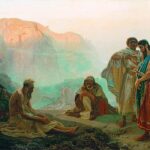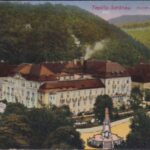What do the books on your shelf say about you? Thanks to the dedication and hard-work of the Beethoven-Haus Bonn, we know a fair amount about Beethoven’s taste in literature. Amongst the list of fine literature, non-fiction, and reference books, we can find a hidden gem: a spiritual text, containing one essay for every day of the year. This book is full of Beethoven’s annotations, providing us with a precious insight into what moved or inspired the great composer, and perhaps gave expression to his philosophical and spiritual beliefs at the time.
The author and title of this treasure:
Christoph Christian Sturm’s Reflections on the Works of God in the Realm of Nature and Providence for Every Day of the Year
Whether or not you have spiritual or religious beliefs of your own, it is likely you would find this book beautifully uplifting and motivating. Reading Sturm’s poetic and passionate lines, one cannot help but marvel at and feel deeply grateful for the incredible variety and splendor of the natural world.
An excerpt from today’s essay (May 30th):
In these beautiful days of spring, let us excite our souls at the sight of so many vegetables which cover the earth, to glorify the power and goodness of our Creator. Wherever we go, we walk on plants and flowers; and as far as we can extend our view, we discover fields and meadows covered with the rich blessings of heaven. If each spire of grass were capable of praising its Author, how many reiterated millions of hymns should arise to Him out of even the narrow compass of one meadow! But O ye beautiful productions of the vegetable kingdom, ye have no need of language; your inimitable dress, your immense number, and the advantages which ye afford the earth, sufficiently proclaim the goodness of the Creator: and your appearance is sufficient to induce us to approach him with heart and voice. Yes, even by you I feel myself drawn to present a sacrifice of thanksgiving to our common Creator. Lovely creatures, continue to flourish! I shall often contemplate your excellencies: and I hope never to do it without a sense of gratitude to My God.
How’s that for a morning meditation?
The book contains a great deal of science that is up to date at the time of publication. An example from the same essay:
More than 20,000 different plants have already been found out and new ones are daily discovered. By the assistance of the microscope, some have been found, where they were least to be expected. Mosses and sponges have been classed among vegetables, and have presented to the naturalist, seeds and flowers before unknown.
Christoph Christian Sturm (1740-1786)
Sturm was born in 1740, he was thirty years Beethoven’s senior. The German preacher and author was known for his warmth and kindness. He preached the love of Christ, and had a strong belief in religious tolerance. His grandfather was a scientist and mathematician, and his father was a lawyer. Science was a family interest, and Sturm’s high level of education is evident in Reflections on the Works of God in the Realm of Nature. Also evident from Sturm’s writings is his great love of nature. The essays encourage the reader to look for God in nature. The topics he touches upon range from the importance of bees to marveling at celestial bodies and the vastness of the universe!
Sturm left a legacy of 37 books covering various religious subject areas. These include Biblical history, song books, many publications for children, and two collections of daily essays. The latter proved to be his most popular two books.
Was Beethoven’s Tempest sonata inspired by Sturm’s writings?
When Beethoven’s secretary, Anton Schindler, asked Beethoven how the Tempest sonata should be interpreted, Beethoven reportedly told his secretary to read (Shakespeare’s) The Tempest in order to understand the piece. Tempest is another word for storm, in the German: sturm. Could Beethoven have been referring to Sturm’s Reflections when Schindler asked about this dramatic and hypnotic piece of music?
Follow the link to learn more about this much loved sonata:
Interesting facts about Beethoven’s Tempest
Beethoven made 117 notations in 72 essays in Reflections on the Works of God in the Realm of Nature. A detailed study of these annotations was made by the late Charles C. Whitcomb of San Jose State University in California. His master’s thesis is a tremendous effort and a fascinating read. It is a unique window into Beethoven’s thinking and his faith; it can be viewed as a reflection of his religious beliefs at the time.
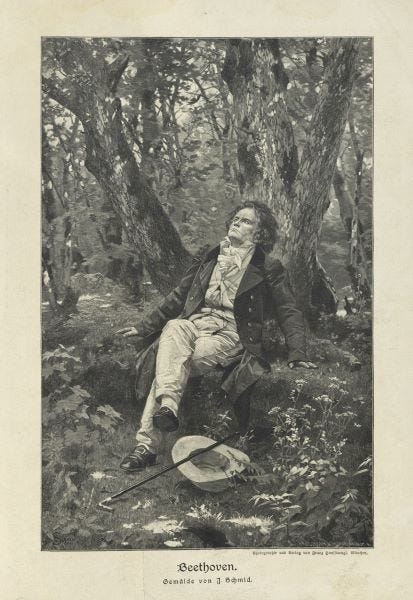
A window into Beethoven’s spirituality
It can be a thrilling experience to stumble upon words that touch us deeply or help express our meaning. Beethoven’s pencil markings in C. C. Sturm’s Reflections on the Works of God in the Realm of Nature, suggest he felt very much this way upon reading the author’s lines.
Summer has inexpressible charms; and gives us daily proofs of the infinite beneficence of the Creator. It is the happy season in which God pours out the treasures of his bounty in the most abundant manner on every living creature. After nature has reanimated us by the pleasures which the spring affords, she labours incessantly throughout the summer to afford us what may gratify our senses, render our subsistence easy, satisfy our wants, and awaken our hearts to sentiments of gratitude and love.
Faith is a deeply personal experience. Beethoven biographer Maynard Solomon suggested the composer had a preference for self-education, and it is not hard to imagine Beethoven shaping his beliefs in this solitary way, through reading and deeper thought.
We also know the composer enjoyed long, contemplative walks in the Viennese countryside, which certainly served as an integral part of his creative process. These nature walks, however, did not only provide a serene environment in which Beethoven could mull over of ideas for his next masterpiece. They meant a great deal more to him.
God in nature
Beethoven read his copy of Sturm’s book in 1816. If we can view the composer’s markings in Sturm’s book as expressive of his own thinking and beliefs at the time, we see a man who found God in nature. The study of those 117 markings also show that the composer was drawn to passages that spoke of a providing and nurturing God.

In a letter to Therese Malfatti, Beethoven once wrote:
How glad I am to be able to roam in the wood and thicket, among trees and flowers and rocks … in the country, every tree seems to speak to me, saying, “Holy! Holy”, in the woods, there is enchantment which expresses all things.
Dr. Whitcomb groups the annotations into themes in his Master’s Thesis, and interestingly, the majority of Beethoven’s markings correspond to passages about nature. Many of these relate to God’s provision for mankind through nature. Others give us fascinating insights into the scientific understanding at the time, and also into Beethoven’s intellectual curiosity.

For example, the essay discussing butterflies caught Beethoven’s attention:
That beneficent being, who gives wisdom to man, has also condescended to instruct the butterfly how to secure the only legacy she can leave to the surviving world, by covering her eggs with a gluey substance which proceeds from her own body. This species of glue is so very tenacious, that rain cannot penetrate it; and that the ordinary cold of winter cannot kill the young ones which are included in the eggs. But it is remarkable, that though every species follows the same method, from generation to generation, yet there is a great diversity in the measures which different species of the butterfly take for the preservation of their race. Naturalists inform us, that some of the insects lay their eggs in the beginning of autumn, and then die; lying over and glued to their dear offspring.
Topics range from the vastness of the universe to the usefulness of venomous animals and plants. Sturm’s scientific writings are each time accompanied by praise of the Creator and thanksgiving, in awe of His goodness and wisdom. An illustrative excerpt:
When the bird in the air astonishes me with the rapidity of its flight, the elegance if its form, and the sweetness of its notes, is it not right that I should consider it as thy work; that its songs are so many hymns to its Creator; and that they should excite me to praise thee?
Dr. Whitcomb suggests that through nature, Beethoven found his trust in God. Nature brought him great spiritual comfort.
…the creation is a scene still more extensive and enchanting for the mind than for the senses. Where the senses cannot reach, the mind discovers beauty, harmony, variety and new pleasures. In all the objects of creation, it perceives the Creator of all things, the source and life of beauty, and the author of all good. Yes, O adorable Being, I see thee in every creature.
Sturm calls upon the reader to seek God in nature, and be grateful for the gifts afforded to us.
The title of the essay for May 4th: An invitation to seek God in the Works of Nature, received thrice emphatic underlining by Beethoven’s hand. An excerpt:
Infinite Being! My most highly prized duty shall be to seek and acknowledge thee in all thy works. Is there a thing in the heavens, or upon the earth, that does not lead to thee, or call to my remembrance thy power, thy wisdom, and thy goodness?
Beethoven’s marking indicate that the composer believed in an omnipotent and omnipresent God.
Beethoven wrote a number of religious compositions. The Gellert Songs, for example, written 14 years before the composer read Sturm’s book, call upon the listener to seek God’s glory in nature.
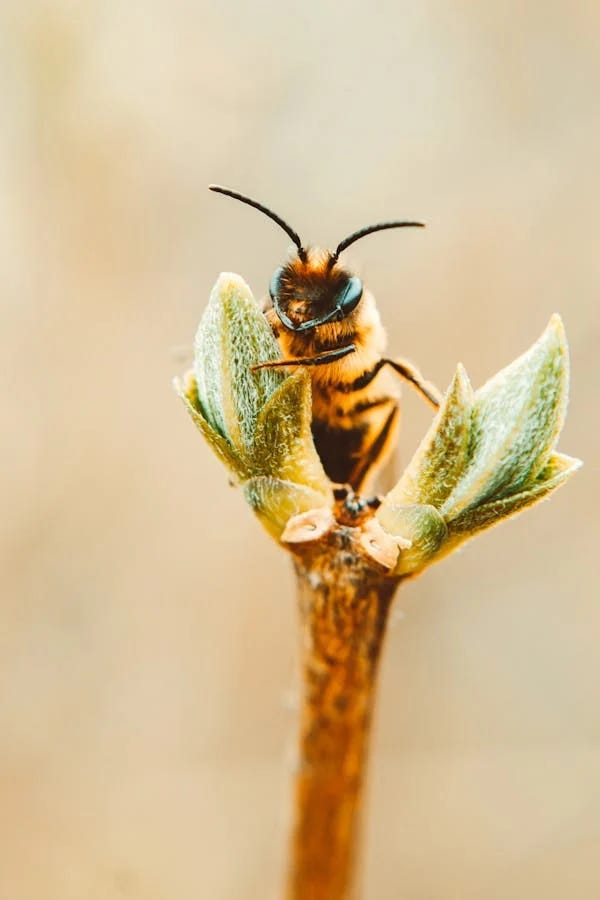
The tiny artist: the bee
It is interesting to look at the essays in Reflections that discuss the characteristics of bees. Beethoven marked several passages that suggest he identified with these busy little creatures, and saw lessons for life through observing their ways. In another essay titled Nature as a school for the heart, Beethoven highlighted the following:
In every respect, the study of nature is profitable; with propriety it may be called a school for the heart; seeing it, in a certain sense, teaches us the duty we owe to God, to our neighbour, and to ourselves.
In the essay titled: The Indefatigable Labours of the Bee, Sturm writes that is not enough to admire these ‘tiny artists’, but that we should attempt to emulate them. Beethoven likely identified with these creatures and the ‘hardships of their short lives’. Through the ideas of endurance and resignation, Sturm will have spoken to him, as he dealt with increasing deafness and poor health.
Beethoven also had a tremendous work ethic, and he no doubt identified with the tireless efforts of these tiny creatures.
O man! go to the school of the bee; consider that wise labourer, and contemplate her works. Admire her activity and industry, by which she turns all to her advantage. Always busy, ever indefatigable, evening and morning she labours, and supports with courage the troubles of a short life.
Peace and harmony
Further markings in Sturm’s Reflections show Beethoven’s interest in the unity of the bee colony, and what we may learn from observing them. The essay Harmony and Patriotism of Bees speaks of the hope that human beings will one day reach this state of harmony. Dr. Witcombe suggests that Beethoven’s markings indicate the composer’s wish for peace in Europe, having been a witness to the invasion of Vienna by Napoleon.
Upon observation of the bee colony, Sturm writes:
We may well learn from these insects, however despicable they may appear in our eyes, those virtues on which the quiet and happiness of our lives depend. In whatever state or condition we may be found, it is necessary that we should, in the true spirit of patriotism, act in concert with our fellow-creatures.
Three little birds
The Sixth Symphony, or Pastoral is Beethoven’s most popular nature-themed composition. Written in F major, the key most often chosen to depict nature during Beethoven’s time, the symphony paints a musical picture, glorifying different aspects of nature.
To learn the titles of each of the five movements, follow this link: Which Beethoven Symphony has five movements?
Beethoven wrote the Sixth Symphony several years before he stumbled upon this book which resonated with him so deeply and gave expression to his spirituality.
In his Master’s Thesis, Dr. Witcombe discusses an article written by musicologist Owen Jander in Music Quarterly in 1993. Jander points out that the second movement, titled: Scene by the Brook, reflects Beethoven’s attempt to deal with his loss of hearing. He suggests that the three birds that appear in the movement: the cuckoo (clarinet), the quail (oboe) and the nightingale (flute) are symbolically significant based on German folklore. The cuckoo’s call is a warning, the quail represents God by reason of its three-note call, and the nightingale’s song is a lamentation.
Jander proposed that the composer’s resignation to deafness is communicated through these three birds: the quail symbolizing Beethoven’s deafness by God’s decree, the cuckoo’s call warning him, and the nightingale representing Beethoven’s lament.
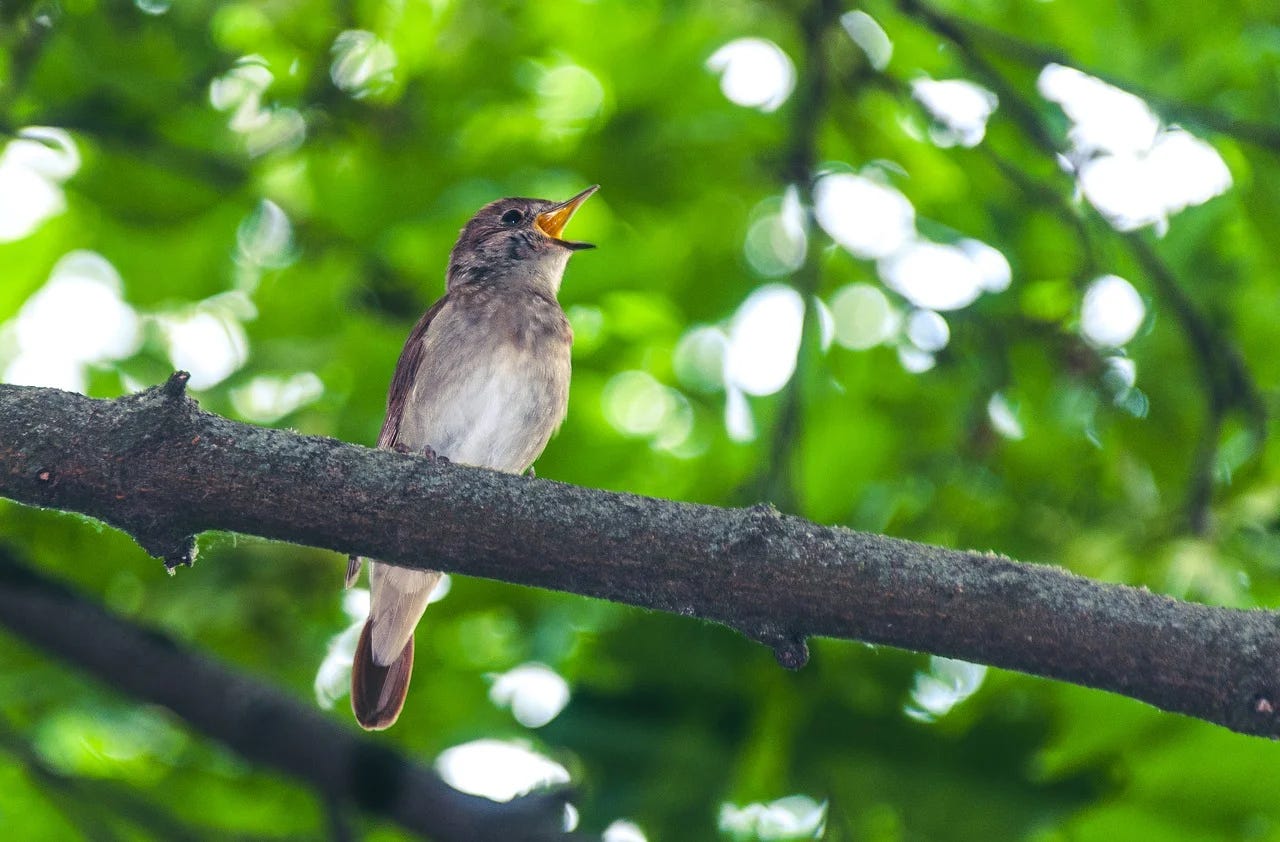
The nightingale
In Reflections, Beethoven marked passages in the essay: The Nightingale, which serve to strengthen this interpretation of the music. The composer may well have identified with the nightingale, as illustrated by the following passages:
Sturm writes that this bird can provide us with…
…the opportunity for many good and edifying thoughts. Should you not learn the truth from him, that sometimes in the ugliest body there can lie hidden a beautiful soul and good qualities? It is only the virtues of the soul which give man his true value and which merit our amazement.
Dr. Whitcombe suggests that the nightingale in the second movement is in fact Beethoven himself. He goes on to say that Beethoven identified with the nightingale’s musical prowess, and that in spite of the challenges he faced, his desire to succeed triumphed.
Sturm praises the Creator for the nightingale’s talent: When we hear the skillful harmony of the nightingale: should it not naturally lead us to that God which is the author of that talent? What wisdom must there be in the formation of this bird, which makes it capable of such sounds!
Beethoven’s markings show that he believed his music to be a gift from God, furthermore, the language of God, as this famous quote by the composer voices:
The vibrations on the air are the breath of God speaking to man’s soul. Music is the language of God. We musicians are as close to God as man can be. We hear his voice, we read his lips, we give birth to the children of God, who sing his praise. That’s what musicians are.
To conclude, a significant aspect of Beethoven’s spirituality is that the God that gave him the decree of deafness, also gave him the strength and ability to overcome it.
(From Beethoven Beats)



